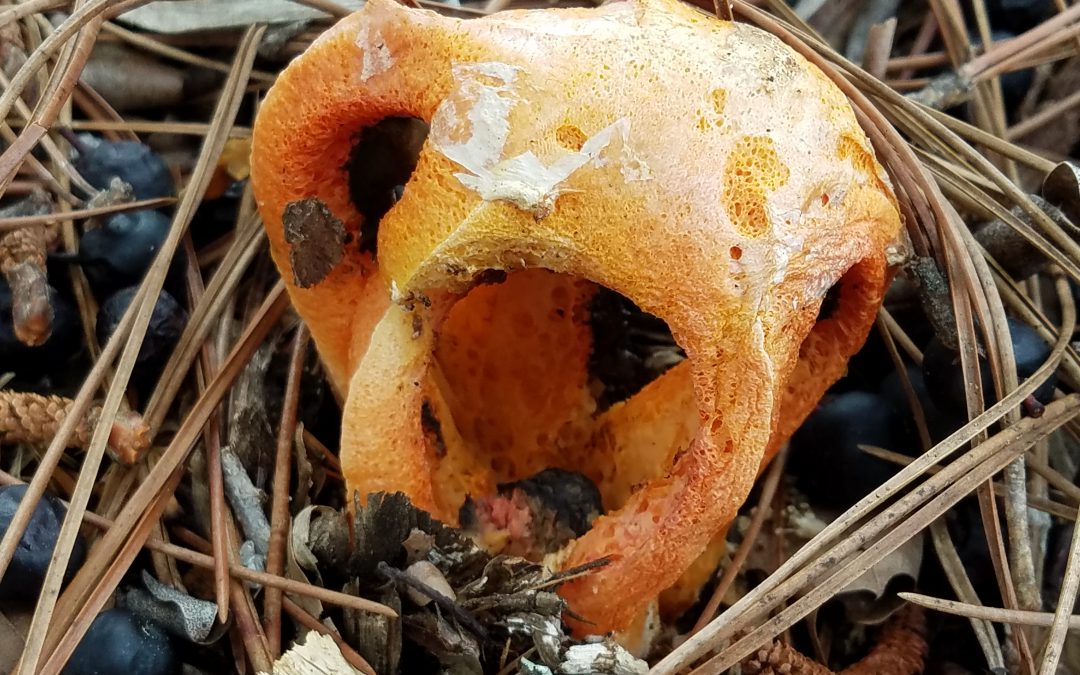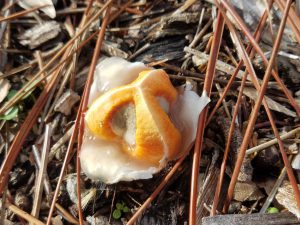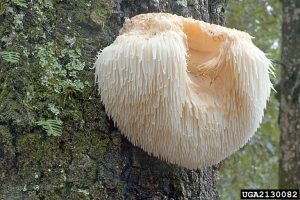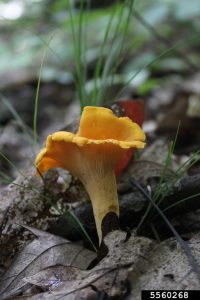
by Evan Anderson | Jul 1, 2021
While there are many fungi that produce mushrooms out in the world around us, there are some that are particularly notable. Edible varieties such as the lion’s mane, jelly ear, and chanterelle may be welcome additions to the landscape. We may have to look out for harmful fungi that cause leaf spots on our landscape plants, toxic mushrooms that could cause harm if ingested, or even things like sooty mold that indicate the presence of another problem (plant-damaging insects, in that case). Then, there are stinkhorn mushrooms.

Stinkhorn Mushroom. Photo courtesy of Evan Anderson.
While not poisonous (indeed, some varieties are edible) and not harmful to plants, these mushrooms are usually unwanted by homeowners. Why? There are two things that make them undesirable. First, they emit an odor that may resemble rotting meat, raw sewage, or some delightful combination of the two. Secondly, some species strongly resemble…well, the genus name Phallus may give some indication. Suffice to say that if your landscape mulch appears to have an inappropriate anatomical addition after a cool rain, you may have a stinkhorn mushroom.
These fungi are decomposers of dead plant material, breaking down wood chips, fallen leaves, or old tree stumps. This is an incredibly important role in the ecosystem, but stinkhorns are particularly offensive as they go about doing their job. The reason for their smell, specifically, is because they need to spread their spores. To do so, they attract insects. Unlike many plants which use beautiful flowers with pleasant fragrances to attract pollinators, stinkhorns attract a different crowd of helpers. They exude a slimy mass of spores that are appealing to flies and other invertebrates that enjoy feces, dead animals, and the like. The insects transport spores from place to place as they feed on the slime.

Stinkhorn Mushroom. Photo courtesy of Evan Anderson.
If you smell or see these mushrooms in your yard or landscape, don’t worry. They won’t last long and may be beneficial to the environment. If they become intolerable, stirring mulch up can help discourage their growth, or they can be removed physically (perhaps with a tool or while wearing gloves, at least). If they recur in an area time after time, look out for their early stages of growth, which may resemble puffballs or small eggs, and remove them then. Fungicides tend not to be effective and may harm other beneficial fungi in the environment.
For more information, see our EDIS publication on stinkhorn mushrooms at https://edis.ifas.ufl.edu/publication/PP345.
by Mark Tancig | Jul 11, 2018
 Guest Post by Leon County Family & Consumer Sciences Agent Heidi Copeland (pictured)
Guest Post by Leon County Family & Consumer Sciences Agent Heidi Copeland (pictured)
With all the rain of late, there seems to be an interest in mycology. You know, the fruiting body of fungi called mushrooms! Edible mushrooms in particular.
It is not unusual; our subtropical summer weather tends to make some fungi flourish! Moreover, apparently, there is a bumper crop of fungi this year. Phone calls to the University of Florida/IFAS Extension office about eating mushrooms has increased. Individuals have even brought mushrooms to the office inquiring if they are of the edible variety.
Our reputation as Extension Agents would certainly be damaged if we did not adhere to a few rules… always read a label, use research-based information, and NEVER tell anyone that a mushroom is edible. It is not that there are not delicious wild mushrooms out there; a recent July 2017, publication of Microbiology Spectrum estimates millions of species. However, even the scientists do not agree as only about 120,000 of them have been described, so far. Not all are edible. Some fungi are poisonous to the point of being deadly.
Matt Smith, an Assistant Professor in the Department of Plant Pathology and the curator of the UF Fungal Herbarium (FLAS) knows a lot about mycology. In fact, he is also the curator of the fungal herbarium managed by the UF Department of Plant Pathology at the Florida Museum of Natural History in Gainesville. The fungal herbarium is a valuable resource and its collections have many important aspects including information about fungi that are deadly poisonous to humans and pets when consumed.

Lion’s Mane mushroom. Credit: Robert Smith; Cabin Bluff Land Management; Bugwood.org
In addition, the UF fungal herbarium is participating in a National Science Foundation-funded project to digitize and database as many US macrofungi collections as possible. This project, the Macrofungi Collection Consortium, includes 34 institutions in 24 states. The project began in July 2012 and will aim to capture data for roughly 1.3 million fungal specimens.
With that said, there is enough scientific research out there to conclude mushroom identification is indeed difficult. Many mushrooms look similar, but are oh so different!
If you are truly interested in eating what you forage MAKE time to study, with experts! Mushrooms, particularly those you plan to eat that are not identified correctly could send you to the emergency room … or worse. The toxicity of a mushroom varies by how much has been consumed. Poisoning symptoms range from stomachaches, drowsiness and confusion, to heart, liver and kidney damage. The symptoms may occur soon after eating a mushroom or can be delayed for six to 24 hours.

Chanterelle mushroom. Credit: Chris Evans; University of Illinois; Bugwood.org
Delayed symptoms are common. Seek help immediately if you think you may have eaten a poisonous mushroom, even if there are no obvious signs of toxicity. Call the Poison Center’s 24-hour emergency hotline at 1-800-222-1222. You will receive immediate, free and confidential treatment advice from the poison experts.
And if you are determined to make foraging for food a recreational hobby or even want to learn more about what is in your Florida yard, the book Common Florida Mushrooms by University of Florida’s Institute of Food and Agricultural Sciences Emeritus Faculty Dr. James Kimbrough, identifies and describes 268 species of mushrooms found in the sunshine state.
Most importantly, teach your children to NEVER eat any mushroom picked from the ground. It is indeed better to be SAFE than sorry.
People who are interested visiting the fungal herbarium should contact:
Dr. Matthew Smith
email: trufflesmith[nospam]@ufl.edu






